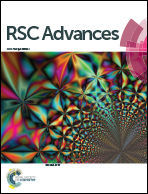Tethering silver ions on amino-functionalized mesoporous silica for enhanced and sustained antibacterial properties
Abstract
Silver ions were tethered onto amino-functionalized Ca-doped mesoporous silica (CaMSS) via the complexing action of Ag+–NH2 for enhanced antibacterial properties. Fourier-transform infrared (FTIR), transmission electron microscopy (TEM), and energy dispersive spectroscopy (EDS) indicated the successful tethering of silver ions onto CaMSS and the complexing action of amino groups enabled the silver ions to be more stable than when adsorbed without amino groups. Minimum inhibitory concentration (MIC) and growth-curve experiments were utilized to test and compare the time- and concentration-dependent antibacterial capability of silver ions tethered- and adsorbed-CaMSS with Escherichia coli (E. coli) as bacteria model. The results showed that at the same silver ion loading, surface-tethered Ag–CaMSS possessed longer and more efficient (2.5 times lower MIC) antibacterial activity during the whole test period compared to the silver ions-adsorbed CaMSS. But with the increasing amount of amino groups, the antibacterial activity was not obviously changed. Further studies demonstrated that the excellent and sustained antibacterial efficiency of silver-tethered CaMSS should be attributed to the stable amino group-based complexing action with Ag, strong interaction of positively-charged CaMSS surface to negatively-charged bacteria, and the strong inhibition effect of Ag+ and agglomerates of silver chloride localized onto the CaMSS surface. All taken together, this amino group-based tethering method is an effective strategy to load Ag ions for sustained and highly efficient antibacterial activity. This developed Ag–CaMSS is a promising surgical implantation material with excellent antibacterial activity.


 Please wait while we load your content...
Please wait while we load your content...